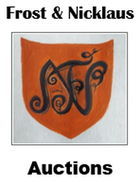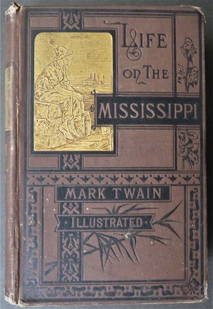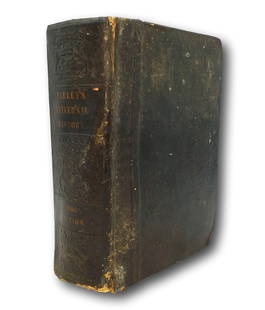
Catherwood, Lazarre, 1st Edition 1901, Castaigne illustrations
Similar Sale History
View More Items in Books, Magazines & PapersRelated Books, Magazines & Papers
More Items in American Books, Magazines & Papers
View MoreRecommended Collectibles
View More














Item Details
Description
"Lazarre" by Mary Hartwell Catherwood, illustrated by Andre Castaigne, published by Bowen-Merrill Co., Indianapolis, copyright 1901. First Edition.
Hard boards, original burgundy color cloth with gilt decorations and lettering; pencil-written signature of John Griff Edwards inside front cont cover; 5" x 7.1/2"; 436 pages printed on high quality laid paper + 12 pages book ads [page 189/190 had repaired long crease]; frontispiece with tissue guard and 5 monochrome plates by Andre Castaigne [listed in Baumgarten's Children's and Illustrated guide. Some yellow stains to plate and the pages next to the plates, very good condition.
This romantic novel is founded upon the legend that at the time of the French Revolution, the Dauphin was spirited away to America by the court painter Bellenger. In the story, the young Prince grows up among the Indians of the Northwest under the name of Eleazer Williams- softened by them to Lazarre. Having been reduced almost to imbecility by previous harsh treatment, the child at first believes himself to be the son of the Indian chief in whose care he has been placed. Under the healthful influence of the climate, he regains both mental and physical strength and, attracting the notice of the settlers, gains an education.
While studying at the manor house, he falls in love with Eagle, Madame De Ferrier, who recognizes him as the Dauphin, seen by her years before in St. Bat's Church, London. When news is received from France of the death of Eagle's husband, Lazarre confesses his love and asks her hand in marriage. Though deeply attached to him, she tells him she cannot marry a King, and starts for France to reclaim her estates. He follows her to France and mingles in the brilliant court of Napoleon, making an unsuccessful plea for recognition to Louis XVIII. After various thrilling adventures he returns to his beloved wilderness in America, where, after years of waiting and searching, he finds Eagle, for whom he renounces the crown, which is offered him by an envoy of the Bourbons, who turn to him as a last resource. The story is one of sustained interest and displays the author's knowledge of the wild country in the old time, as well as her fertile imagination. The character of the Prince is an interesting study and that of Eagle is drawn with remarkable charm and skill. [H.R. Keller.]
Mary Hartwell Catherwood was an American writer of popular historical romances, short stories, and poetry. Early in her career she published under her birth name, Mary Hartwell, and under the pseudonym Lewtrah. She traveled and lived throughout the Midwestern United States and developed her signature style of incorporating Midwestern culture, dialect, and local color into her texts. Although most of her novels and stories are set in Ohio, Indiana, and Illinois, some are also based in the area along the Canada US border near Quebec and on colonial Mackinac Island.
Jean Alexandre Michel Andre Castaigne (1861-1929) was a French artist and engraver, a student of Jean-Leon Gerome and Alexandre Cabanel. Subsequently he became a leading illustrator in the United States. He is often recalled as the original illustrator of the first edition of "The Phantom of the Opera".
Castaigne also created more than 36 art pieces about Alexander the Great for an 1898–99 series. As an illustrator, he captured images of the first modern olympics; he drew pictures of the 1896 Olympic Games for "Scribner's Magazine".
In 1878, he began his studies at what was then the Academie Suisse. After a few months he transferred to the Academie des Beaux-Arts where his two mentors taught. He was in Cabanel's studio for a year before moving to Gerome's studio where he won first place in the General Competition three times-for nude figure painting, composition, and general excellence.
In 1884, he had his first exhibition in Paris, from whence his painting "Dante et Beatrice" went on tour to New Orleans where it received a great deal of attention. In 1887, he exhibited the huge painting, five yards by four, "The Deluge", which later was placed in the municipal gallery of his native city Angouleme. In 1888, he painted a portrait of the Vicomte de Dampierre in his hunting jacket and in 1889 he created a painting titled "After the Combat", which later was acquired by the Peabody Gallery in Baltimore
In 1890, Castaigne went to the United States where he remained until 1895. He became director of an art school in Baltimore called the Charcoal Club. He painted several notable portraits the first year he was in America. In 1891, he began the illustrating work; "The Forty-Niners' Ball" and "The Bowery" for the 'Century Magazine'. These images of the West earned him immediate recognition as a master of a very American art form. After that he illustrated for several of the leading magazines. His designs included pictures of Texas cowboys in 'Scribner's Magazine' - On the Great Cattle Trail (1892), part of a series titled "Cattle Trails of the Prairies" and the World's Fair drawings. In 1893, he painted eight illustrations for an article by A.C. Fletcher on the Omaha tribe in The Century. He illustrated B.I. Wheeler's "Life of Alexander the Great" (1900), for which he did over 36 paintings and drawings. For 'The Century' he did over 160 illustrations. He also worked for 'Harper's Magazine' from 1901 to 1913. He was official painter for the Olympic Games in 1896.
On his return to France in 1895, he became instructor in the Academie Colarossi and opened a studio in Paris. He remained permanent European correspondent for 'The Century' and made trips to the US from time to time to do American illustrations for the magazine.
While in France, Castaigne was principal draughtsman to the President of France Félix Faure who awarded him the Red Ribbon of the Legion of Honour.
Provenance:
From the library of John Griff Edwards, Portsmouth, Virginia.
John Griff Edwards (1870-1912) belonged to the old established settler family in Virginia. His father and uncles served in the Army of Northern Virginia during the Civil War. The grandfather, LeRoy Griffin Edwards (1804-1866), was the president of the Confederate Convention of 1864. John's wife, Mrs. J. Griff Edwards founded and led the first of the United Confederate Choirs of America (1907). After that she was elected the Commander in Chief of the United Confederate Choirs.” In 1911 she published a volume titled "Echoes From Dixie A Collection of Songs Used in the South."
Note:
Country restrictions may apply - the lesser expansive Priority or 1st Class shipping may not be available to all countries.
US: Priority (c.2-4 days) ------------- $10.50
Canada: 1st Class (c.2-6 weeks) ---- $26.50
World: 1st Class (c.2-8 weeks) ----- $34.50
Hard boards, original burgundy color cloth with gilt decorations and lettering; pencil-written signature of John Griff Edwards inside front cont cover; 5" x 7.1/2"; 436 pages printed on high quality laid paper + 12 pages book ads [page 189/190 had repaired long crease]; frontispiece with tissue guard and 5 monochrome plates by Andre Castaigne [listed in Baumgarten's Children's and Illustrated guide. Some yellow stains to plate and the pages next to the plates, very good condition.
This romantic novel is founded upon the legend that at the time of the French Revolution, the Dauphin was spirited away to America by the court painter Bellenger. In the story, the young Prince grows up among the Indians of the Northwest under the name of Eleazer Williams- softened by them to Lazarre. Having been reduced almost to imbecility by previous harsh treatment, the child at first believes himself to be the son of the Indian chief in whose care he has been placed. Under the healthful influence of the climate, he regains both mental and physical strength and, attracting the notice of the settlers, gains an education.
While studying at the manor house, he falls in love with Eagle, Madame De Ferrier, who recognizes him as the Dauphin, seen by her years before in St. Bat's Church, London. When news is received from France of the death of Eagle's husband, Lazarre confesses his love and asks her hand in marriage. Though deeply attached to him, she tells him she cannot marry a King, and starts for France to reclaim her estates. He follows her to France and mingles in the brilliant court of Napoleon, making an unsuccessful plea for recognition to Louis XVIII. After various thrilling adventures he returns to his beloved wilderness in America, where, after years of waiting and searching, he finds Eagle, for whom he renounces the crown, which is offered him by an envoy of the Bourbons, who turn to him as a last resource. The story is one of sustained interest and displays the author's knowledge of the wild country in the old time, as well as her fertile imagination. The character of the Prince is an interesting study and that of Eagle is drawn with remarkable charm and skill. [H.R. Keller.]
Mary Hartwell Catherwood was an American writer of popular historical romances, short stories, and poetry. Early in her career she published under her birth name, Mary Hartwell, and under the pseudonym Lewtrah. She traveled and lived throughout the Midwestern United States and developed her signature style of incorporating Midwestern culture, dialect, and local color into her texts. Although most of her novels and stories are set in Ohio, Indiana, and Illinois, some are also based in the area along the Canada US border near Quebec and on colonial Mackinac Island.
Jean Alexandre Michel Andre Castaigne (1861-1929) was a French artist and engraver, a student of Jean-Leon Gerome and Alexandre Cabanel. Subsequently he became a leading illustrator in the United States. He is often recalled as the original illustrator of the first edition of "The Phantom of the Opera".
Castaigne also created more than 36 art pieces about Alexander the Great for an 1898–99 series. As an illustrator, he captured images of the first modern olympics; he drew pictures of the 1896 Olympic Games for "Scribner's Magazine".
In 1878, he began his studies at what was then the Academie Suisse. After a few months he transferred to the Academie des Beaux-Arts where his two mentors taught. He was in Cabanel's studio for a year before moving to Gerome's studio where he won first place in the General Competition three times-for nude figure painting, composition, and general excellence.
In 1884, he had his first exhibition in Paris, from whence his painting "Dante et Beatrice" went on tour to New Orleans where it received a great deal of attention. In 1887, he exhibited the huge painting, five yards by four, "The Deluge", which later was placed in the municipal gallery of his native city Angouleme. In 1888, he painted a portrait of the Vicomte de Dampierre in his hunting jacket and in 1889 he created a painting titled "After the Combat", which later was acquired by the Peabody Gallery in Baltimore
In 1890, Castaigne went to the United States where he remained until 1895. He became director of an art school in Baltimore called the Charcoal Club. He painted several notable portraits the first year he was in America. In 1891, he began the illustrating work; "The Forty-Niners' Ball" and "The Bowery" for the 'Century Magazine'. These images of the West earned him immediate recognition as a master of a very American art form. After that he illustrated for several of the leading magazines. His designs included pictures of Texas cowboys in 'Scribner's Magazine' - On the Great Cattle Trail (1892), part of a series titled "Cattle Trails of the Prairies" and the World's Fair drawings. In 1893, he painted eight illustrations for an article by A.C. Fletcher on the Omaha tribe in The Century. He illustrated B.I. Wheeler's "Life of Alexander the Great" (1900), for which he did over 36 paintings and drawings. For 'The Century' he did over 160 illustrations. He also worked for 'Harper's Magazine' from 1901 to 1913. He was official painter for the Olympic Games in 1896.
On his return to France in 1895, he became instructor in the Academie Colarossi and opened a studio in Paris. He remained permanent European correspondent for 'The Century' and made trips to the US from time to time to do American illustrations for the magazine.
While in France, Castaigne was principal draughtsman to the President of France Félix Faure who awarded him the Red Ribbon of the Legion of Honour.
Provenance:
From the library of John Griff Edwards, Portsmouth, Virginia.
John Griff Edwards (1870-1912) belonged to the old established settler family in Virginia. His father and uncles served in the Army of Northern Virginia during the Civil War. The grandfather, LeRoy Griffin Edwards (1804-1866), was the president of the Confederate Convention of 1864. John's wife, Mrs. J. Griff Edwards founded and led the first of the United Confederate Choirs of America (1907). After that she was elected the Commander in Chief of the United Confederate Choirs.” In 1911 she published a volume titled "Echoes From Dixie A Collection of Songs Used in the South."
Note:
Country restrictions may apply - the lesser expansive Priority or 1st Class shipping may not be available to all countries.
US: Priority (c.2-4 days) ------------- $10.50
Canada: 1st Class (c.2-6 weeks) ---- $26.50
World: 1st Class (c.2-8 weeks) ----- $34.50
Buyer's Premium
- 0%
Catherwood, Lazarre, 1st Edition 1901, Castaigne illustrations
Estimate $50 - $100
Get approved to bid.
Shipping & Pickup Options
Item located in Petersburg, VA, us$10.5 shipping in the US
Payment
Accepts seamless payments through LiveAuctioneers

TOP

















![Childs Book of Prayers, Masha illustrations 1st Edition 1941: "A Child's Book of Prayers", selected by Louise Raymond, illustrated by Masha, published by Random House, New York, 1941. First edition. Original illustrated hard boards [some wear]; large format [9.1](https://p1.liveauctioneers.com/6304/266436/139770162_1_x.jpg?height=310&quality=70&version=1668866616)




![Cross, Tommy and Indians, 1st Edition 1950, illustrated by Vegh: "Tommy and the Indians" by Genevieve Cross, illustrations by Steven Vegh, published by Cross Publications, New York, 1950. Stated First Edition. Hard boards [some wear and staining: see photos]; large](https://p1.liveauctioneers.com/6304/269989/142245957_1_x.jpg?height=310&quality=70&version=1671297983)
![Saxe, Fly-Ing Dutchman, Satirical Poem, 1st Edition 1862 illustrated: "The Fly-Ing Dutchman; Or, the Wrath of Herr Vonstoppelnoze" by John G. Saxe. with sixteen comic illustrations, published by Carleton, New York, 1862, First Edition with MDCCCLXII [1862] on the bottom](https://p1.liveauctioneers.com/6304/266436/139375923_1_x.jpg?height=310&quality=70&version=1668866616)







![Little Golden ABC, 1st US Ed. 1951, Cornelius DeWitt illustrations: "The Little Golden ABC", pictures by Cornelius DeWitt, published by Golden Press, New York, 1951. First Edition. Illustrated hard boards [a little wear and small surface damages: see photos], 6.3/4" x](https://p1.liveauctioneers.com/6304/306619/164522606_1_x.jpg?height=310&quality=70&version=1699706364)
































![[CIVIL WAR]. [BELL, William H., photographer]. CDV of a wounded soldier identified as Private George: [CIVIL WAR]. [BELL, William H., photographer]. CDV of a wounded soldier identified as Private George Ruoss, 7th New York Veteran Infantry, featured naked below the waist. CDV on cardstock mount (light](https://p1.liveauctioneers.com/197/329785/177758300_1_x.jpg?height=310&quality=70&version=1715625218)












